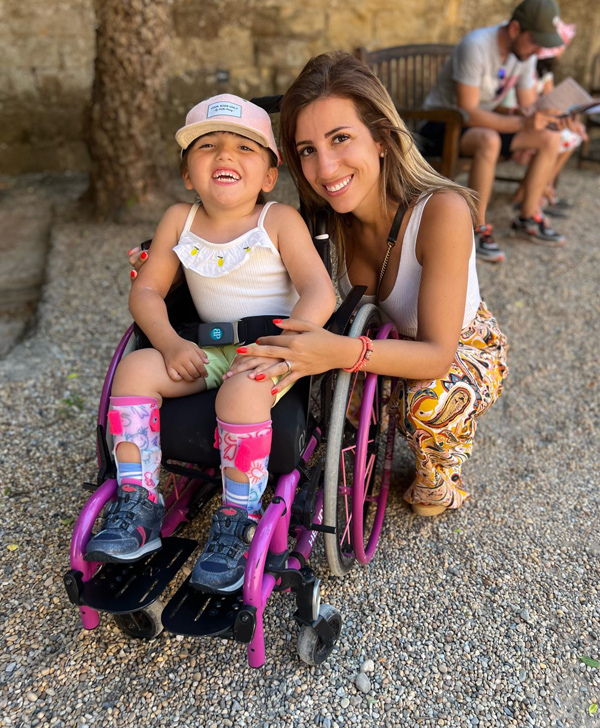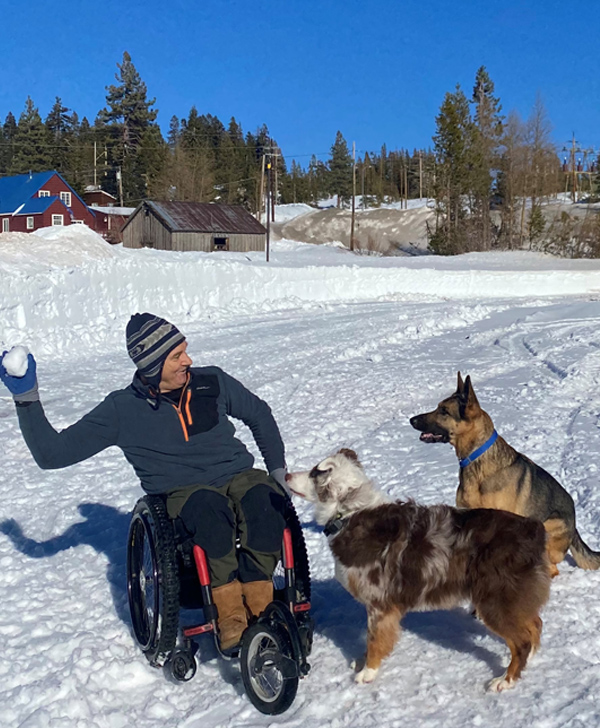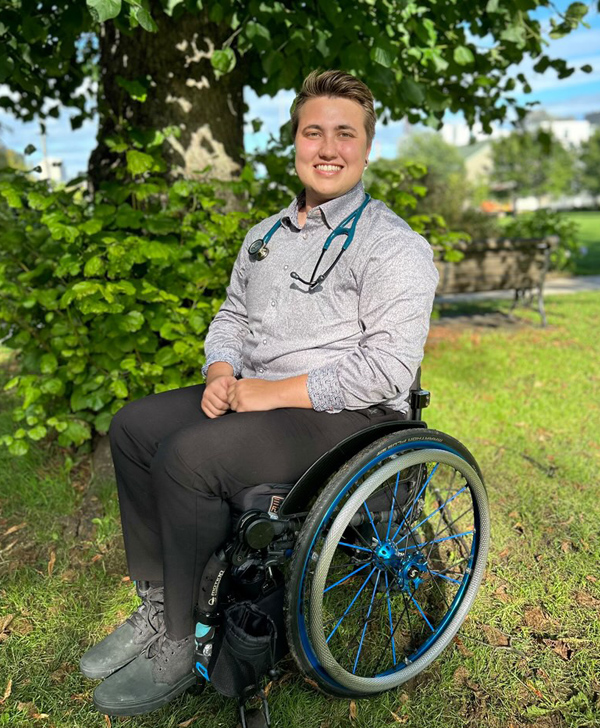Representation Matters – Disability Pride Month
When I moved from Mexico to Canada in 2018, I never thought that my first job would be working for a wheelchair company, but after 6 years (and counting), I’m still here!
When I moved from Mexico to Canada in 2018, I never thought that my first job would be working for a wheelchair company, but after 6 years (and counting), I’m still here!
Let’s go back to 2018; I had just finished my bachelor’s in international business and moved to Canada right after that. I was impressed by the Canadian winter, the mountains of snow accumulating in front of each house, how the people's warmth and welcoming nature compensate for the cold weather, and, of course, the impactful flavor of (real) maple syrup.
After only a few months of living here, I received my job permit, and the search for a job started. It did not take long before I found Motion Composites. “Wheelchairs? Could be interesting," I said to myself before sending in my resume. The following steps happened in a blur, and after my interview, a week passed, and I got the call—the job was mine. And from that moment, things began to shift for me.
I remember clearly my first day at the job, feeling uneasy about seeing wheelchairs everywhere, being built, being trialed, and hearing people talking about disabilities, residual limb supports, and the different types of wheels and locks.
At the time, all I knew and had been exposed to both wheelchairs and people with disabilities was what the media (movies, books, and TV shows) portrayed. I felt like I had entered a new dimension. In this new world, talking about disabilities and the clinical rationale behind every part of a wheelchair was studied and respected (almost like a religion) by nearly every single person working for Motion Composites. I learned pretty quickly that everything I knew about disabilities was wrong. I began a rediscovery of this world from a vastly different perspective, and this changed EVERYTHING.
One of the first things I discovered is that in the everyday realm, there is very little education or discussion about disabilities. This means that most of what is known about disabilities comes from the media, and the media often gets it completely wrong.
Over the last six years, I have learned so much! I learned about ambulatory wheelchair users, Ehlers-Danlos Syndrome, Spina Bifida, Cerebral Palsy, and Spinal Cord Injuries (complete and incomplete ones), and much more. I have learned that navigating through the world using a wheelchair is even more complicated than most fully abled people think.
Did you know that more than one billion people around the world live with some form of disability? This represents around 15% of the global population, making them the single largest minority group in the world!! So, why is it the most underrepresented in the media?
We often ask for representation of minorities in the media, and this should not just mean racial minorities, but also disabled people.
As a fully abled person, I am not going to lie; the ability to do whatever is desired can blind you. The world lacks visibility in many aspects, but the one that is often misrepresented is the disabled community, and somehow, Hollywood and the media is not bashed or blamed for this.
As a proud Latina, I understand the importance of representation for my ethnicity, so I think, "Why not try to support the disabled community in getting that proper representation?" And often, a correct depiction within the media could lead to better representation in all aspects of society.
In the case of the disabled community, representation can bring more than just visibility to the disabled community as a minority. More representation could make more people aware of the daily challenges that come from navigating the inaccessible world.
Humor me; imagine your daily routine. Think of every task and activity you must do. How do you get to your job? Do you take public transportation? Expand that thinking to weekly tasks. What about going to the store, or out to eat? Now imagine completing all those activities with a mobility device. What could be some of your struggles? Are there ramps and accessible entrances? Are the bathrooms on the same floor level? Are there accessible stalls? Are there elevators? Are the tables at a suitable height for a wheelchair user to use? Are the doors heavy?
If you cannot picture it, I recommend that you watch this amazing video by Jackson Ryan and his roommate, Princewill. As part of their physical therapy school curriculum, they spent 24 hours using a wheelchair to simulate the life of a manual wheelchair user. The purpose of this was to draw attention and understanding to the many challenges faced daily for people utilizing wheelchairs.
My last six years of both working for a wheelchair manufacturer and interacting with the wheelchair community have impacted my life significantly. Reflecting on the world in this way has led me to become involved in advocacy. I know that I have only begun to realize the daily struggles that the disabled community faces to live independently, but I believe this is a start. The more people that become involved in advocacy alongside the disabled community, the more representation they will have, and hopefully this leads to a more accessible world for all.
More representation means more visibility, and more visibility can bring more accessibility.
I have had the opportunity to meet some extraordinary people in my role as Digital Marketing Specialist for Motion Composites. From world record-breaking athletes to artists from all over the world. From a 15-year-old young wheelchair user who is just learning how to move around the world independently, to an 87-year-old veteran who talked to me about why he was proud to be sitting in one of the wheelchairs that we manufactured.
For this special article, I decided to speak with some of them to gain insight into why, for them, representation matters, and their responses are exactly what we needed to hear!
"For Sofia, her wheelchair is an extension of her freedom and her personality. I want her to grow up in a world where she feels proud and valued, and where she sees people like her represented in an authentic, strong, and inclusive way.
By sharing our experiences and highlighting the diverse journeys of wheelchair users, we can inspire, raise awareness, and show that access, inclusion, and respect are fundamental rights for everyone. This is the vision I want to carry for my daughter and for all the families who share this path." – Ana Leite Freitas - Sofia’s Mom

“Back in 1985, when I was a newly injured T-10 complete paraplegic, it seemed that disability awareness and inclusion, especially in the media, was in its infancy. It was rare to find any realistic portrayal of disability, and rarer still to see the endless possibilities of a life with disability that lay ahead of me. To me, seeing people with disabilities represented in the media is important because it shows the possibilities, and can help bring to life awareness of barriers (and importance of removing them), ranging from lack of curb cuts, to showing the importance of equal employment opportunities. More awareness leads to better accessibility, which leads to more opportunity.”

“Representation of wheelchair users is important because it makes me feel special and included. I rarely see anyone else in a wheelchair (that’s not old). When I was younger, one of my favorite toys was a toy wheelchair and orthotics for my dolls. I used to pretend they were like me. That’s why I started modeling. So others like me can be seen. Representation and inclusion matter.”
“When I first ended up in a wheelchair, I only knew a couple of people who used wheelchairs, but no one really knew the struggles I was about to face. While I learned how to navigate my everyday tasks, what held me back most were the assumptions from others on my abilities. Most of the time it was a lack of adaptive thinking, which ultimately comes down to a lack of representation of wheelchair users in everyday spaces. I was the 1st student in a wheelchair to be admitted to my medical school, which I am now in 2nd year, and my biggest barrier remains a lack of adaptive thinking.
There was an initial barrier to questioning my abilities, but it only took me 20 minutes to demonstrate that I could keep up, take patient histories, perform physical exams, and be like every other medical student. If we had more representation in the field, then maybe that initial questioning wouldn’t even occur. More representation of wheelchair users creates spaces with less stigma and more access. It allows disabled people to have goals and aspirations that they know can be achieved, and to see their wheelchair as a tool for success rather than a barrier.”

We want to thank our friends who shared their opinions with us. Be sure to follow them and check out their daily adventures in their Motion Composites wheelchairs.
If you are going to take anything from this article, let it be to learn more about people living with disabilities and how to become involved in advocacy alongside the disabled community. Advocating can bring change in legislation, in the media, and in funding programs.
Advocacy holds more power than we think! Let’s work together to build a better world for everyone, and why not? Let’s become allies to the largest minority in the world.
National Disability Rights Network
The American Association of People with Disabilities
Many more groups exist. Search for advocacy groups local to your area.
